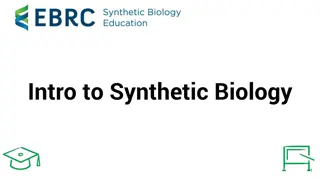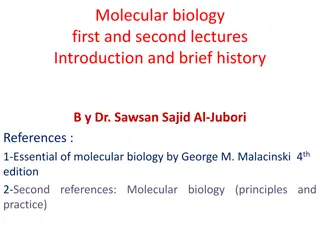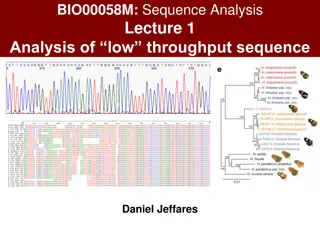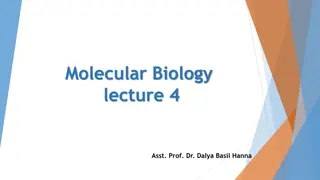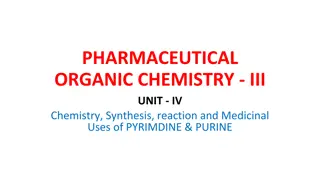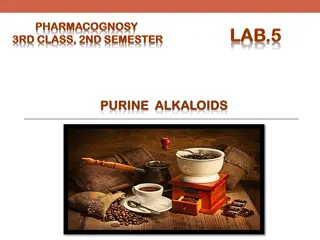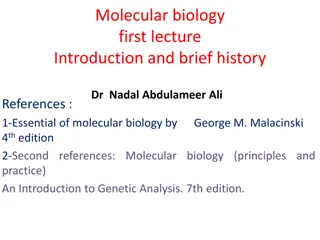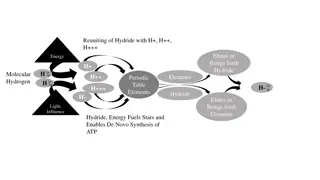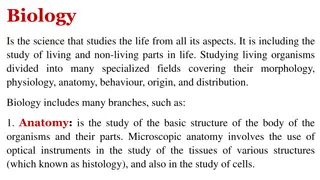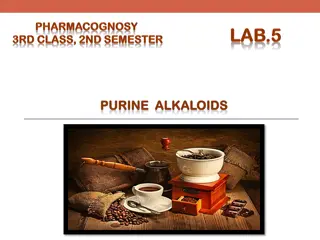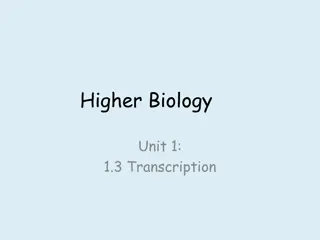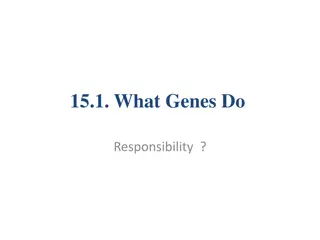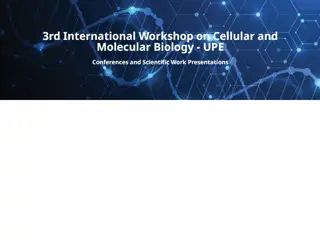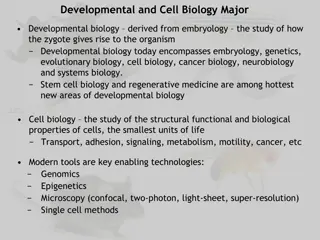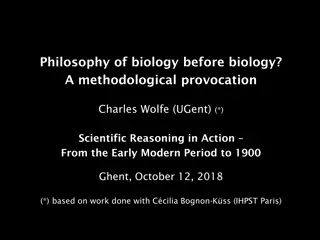Purine Nucleotide Synthesis in Molecular Biology
The process of Purine Nucleotide Synthesis involves the formation of purine ribonucleotides, breakdown into uric acid, and the detailed steps of purine nucleotide synthesis. Key components like IMP, SAICAR, PRPP, and ATP play crucial roles in this complex metabolic pathway, offering insights into the synthesis of essential cellular components.
Download Presentation

Please find below an Image/Link to download the presentation.
The content on the website is provided AS IS for your information and personal use only. It may not be sold, licensed, or shared on other websites without obtaining consent from the author.If you encounter any issues during the download, it is possible that the publisher has removed the file from their server.
You are allowed to download the files provided on this website for personal or commercial use, subject to the condition that they are used lawfully. All files are the property of their respective owners.
The content on the website is provided AS IS for your information and personal use only. It may not be sold, licensed, or shared on other websites without obtaining consent from the author.
E N D
Presentation Transcript
P.G. Nucleic Acid Metabolism VBC-607 Unit-1 16.10.2020
Nucleotide Metabolism PURINE RIBONUCLEOTIDES: formed de novo i.e., purines are not initially synthesized as free bases First purine derivative formed is Inosine Mono-phosphate (IMP) The purine base is hypoxanthine AMP and GMP are formed from IMP
Purine Nucleotides Get broken down into Uric Acid (a purine) Buchanan (mid 1900s) showed where purine ring components came from: N1: Aspartate Amine C2, C8: Formate N3, N9: Glutamine C4, C5, N7: Glycine C6: Bicarbonate Ion
Purine Nucleotide Synthesis O COO OOC C N 2-O3P H N O CH2 HC N H C Aspartate + ATP O C ADP + Pi 4 4 H H CH CH CH2 5 5 C C H OH N N OH OH H2N COO H2N SAICAR Synthetase -D-Ribose-5-Phosphate (R5P) Ribose-5-Phosphate Ribose-5-Phosphate ATP 5-Aminoimidazole-4-(N-succinylocarboxamide) ribotide (SAICAR) Carboxyamidoimidazole Ribotide (CAIR) Ribose Phosphate Pyrophosphokinase ADP + Pi AIR Car boxylase AMP Fumarate Adenylosuccinate Lyase ATP +HCO3 O N C HC 2-O3P H O CH2 4 O N H2N O O CH C H H 4 5 C CH H P O P O O N 5 C OH OH H2N N O O H2N Ribose-5-Phosphate Ribose-5-Phosphate 5-Aminoimidazole Ribotide (AIR) 5-Aminoimidazole-4-carboxamide ribotide (AICAR) 5-Phosphoribosyl- -pyrophosphate (PRPP) ADP + Pi AIR Synthetase Glutamine + H2O N10-Formyl- THF Amidophosphoribosyl Transferase ATP AICAR Transformylase H N O Glutamate + PPi THF C H2C CH N H2N 2-O3P C NH2 O CH2 4 O CH C O H H 5 C HN NH N H H O C H NH OH OH Ribose-5-Phosphate Ribose-5-Phosphate -5-Phosphoribosylamine (PRA) Formylglycinamidine ribotide (FGAM) 5-Formaminoimidazole-4-carboxamide ribotide (FAICAR) ADP + Glutamate + Pi Glycine + ATP FGAM Synthetase H2O GAR Synthetase IMP Cyclohydrolase ATP + Glutamine + H2O ADP + Pi O H N C H2C NH2 N HN C H2C CH 4 CH O C 5 HC C C O N 2-O3P N NH O CH2 N10-Formyl-THF O NH THF O 2-O3P O CH2 H H O H H H H H Ribose-5-Phosphate H GAR Transformylase OH OH OH OH Formylglycinamide ribotide (FGAR) Inosine Monophosphate (IMP) Glycinamide Ribotide (GAR)
Purine Nucleotide Synthesis at a Glance ATP is involved in 6 steps PRPP in the first step of Purine synthesis is also a precursor for Pyrimidine Synthesis, His and Trp synthesis Role of ATP in first step is unique group transfer rather than coupling In second step, C1 notation changes from to (anomers specifying OH positioning on C1 with respect to C4 group) In step 2, PPi is hydrolyzed to 2Pi (irreversible, committing step)
Regulatory Control of Purine Nucleotide Biosynthesis GTP is involved in AMP synthesis and ATP is involved in GMP synthesis (reciprocal control of production) PRPP is a biosynthetically central molecule (why?) ADP/GDP levels negative feedback on Ribose Phosphate Pyrophosphokinase Amidophosphoribosyl transferase is activated by PRPP levels APRT activity has negative feedback at two sites ATP, ADP, AMP bound at one site GTP,GDP AND GMP bound at the other site Rate of AMP production increases with increasing concentrations of GTP; rate of GMP production increases with increasing concentrations of ATP
Purine Catabolism and Salvage All purine degradation leads to uric acid (but it might not stop there) Ingested nucleic acids are degraded to nucleotides by pancreatic nucleases, and intestinal phosphodiesterases in the intestine Group-specific nucleotidases and non-specific phosphatases degrade nucleotides into nucleosides Direct absorption of nucleosides Further degradation Nucleoside + H2O base + ribose (nucleosidase) Nucleoside + Pi base + r-1-phosphate (n. phosphorylase) NOTE: MOST INGESTED NUCLEIC ACIDS ARE DEGRADED AND EXCRETED.
Intracellular Purine Catabolism Nucleotides broken into nucleosides by action of 5 -nucleotidase (hydrolysis reactions) Purine nucleoside phosphorylase (PNP) Inosine Hypoxanthine Xanthosine Xanthine Guanosine Guanine Ribose-1-phosphate splits off Can be isomerized to ribose-5-phosphate Adenosine is deaminated to Inosine (ADA)
Intracellular Purine Catabolism Xanthine is the point of convergence for the metabolism of the purine bases Xanthine Uric acid Xanthine oxidase catalyzes two reactions Purine ribonucleotide degradation pathway is same for purine deoxyribonucleotides
Xanthosine Degradation Ribose sugar gets recycled (Ribose-1-Phosphate R-5-P ) can be incorporated into PRPP (efficiency) Hypoxanthine is converted to Xanthine by Xanthine Oxidase Guanine is converted to Xanthine by Guanine Deaminase Xanthine gets converted to Uric Acid by Xanthine Oxidase
Xanthine Oxidase A homodimeric protein Contains electron transfer proteins FAD Mo-pterin complex in +4 or +6 state Two 2Fe-2S clusters Transfers electrons to O2 H2O2 H2O2 is toxic Disproportionated to H2O and O2 by catalase
Purine Salvage Adenine phosphoribosyl transferase (APRT) Adenine + PRPP AMP + PPi Hypoxanthine-Guanine phosphoribosyl transferase (HGPRT) Hypoxanthine + PRPP IMP + PPi Guanine + PRPP GMP + PPi (NOTE: THESE ARE ALL REVERSIBLE REACTIONS) AMP,IMP,GMP do not need to be resynthesized de novo !
Gout Impaired excretion or overproduction of uric acid Uric acid crystals precipitate into joints (Gouty Arthritis), kidneys, ureters (stones) Lead impairs uric acid excretion lead poisoning from pewter drinking goblets Fall of Roman Empire? Xanthine oxidase inhibitors inhibit production of uric acid, and treat gout Allopurinol treatment hypoxanthine analog that binds to Xanthine Oxidase to decrease uric acid production
Pyrimidine Ribonucleotide Synthesis Uridine Monophosphate (UMP) is synthesized first CTP is synthesized from UMP Pyrimidine ring synthesis completed first; then attached to ribose-5- phosphate N1, C4, C5, C6 : Aspartate C2 : HCO3- N3 : Glutamine amide Nitrogen
Pyrimidine Synthesis O - + Glutamine + H2O 2 ATP + HCO3 C CH HN 2 ADP + Glutamate + Pi O Carbamoyl Phosphate Synthetase II C C N C O COO CH HN PRPP PPi 2-O3P O CH2 O NH2 H H C C Orotate Phosphoribosyl Transferase N H O H O C H COO OH OH -2 O PO3 Orotidine-5'-monophosphate (OMP) Orotate Carbamoyl Phosphate Reduced Quinone Aspartate OMP Decarboxylase Aspartate Transcarbamoylase (ATCase) Dihydroorotate Dehydrogenase CO2 Quinone Pi O C O O CH HN C HO C C CH CH2 HN N CH2 O H2O NH2 2-O3P C CH O CH2 O C CH N H O H H Dihydroorotase N H COO O H H COO OH OH Dihydroorotate Carbamoyl Aspartate Uridine Monophosphate (UMP)
UMP Synthesis Overview 2 ATPs needed: both used in first step One transfers phosphate, the other is hydrolyzed to ADP and Pi 2 condensation rxns: form carbamoyl aspartate and dihydroorotate (intramolecular) Dihydroorotate dehydrogenase is an intra- mitochondrial enzyme; oxidizing power comes from quinone reduction Attachment of base to ribose ring is catalyzed by OPRT; PRPP provides ribose-5-P PPi splits off PRPP irreversible Channeling: enzymes 1, 2, and 3 on same chain; 5 and 6 on same chain
OMP DECARBOXYLASE : THE MOST CATALYTICALLY PROFICIENT ENZYME FINAL REACTION OF PYRIMIDINE PATHWAY ANOTHER MECHANISM FOR DECARBOXYLATION A HIGH ENERGY CARBANION INTERMEDIATE NOT NEEDED NO COFACTORS NEEDED ! SOME OF THE BINDING ENERGY BETWEEN OMP AND THE ACTIVE SITE IS USED TO STABILIZE THE TRANSITION STATE PREFERENTIAL TRANSITION STATE BINDING
UMP UTP and CTP Nucleoside monophosphate kinase catalyzes transfer of Pi to UMP to form UDP; nucleoside diphosphate kinase catalyzes transfer of Pi from ATP to UDP to form UTP CTP formed from UTP via CTP Synthetase driven by ATP hydrolysis Glutamine provides amide nitrogen for C4 in animals
Regulatory Control of Pyrimidine Synthesis Differs between bacteria and animals Bacteria regulation at ATCase rxn Animals regulation at carbamoyl phosphate synthetase II UDP and UTP inhibit enzyme; ATP and PRPP activate it UMP and CMP competitively inhibit OMP Decarboxylase *Purine synthesis inhibited by ADP and GDP at ribose phosphate pyrophosphokinase step, controlling level of PRPP also regulates pyrimidines


